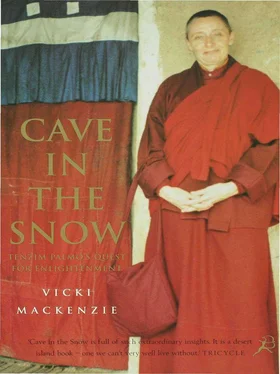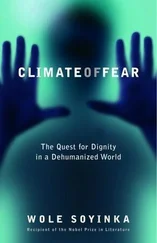With the lid off, other ‘wronged’ parties came to light to blow the whistle on their gurus. One woman brought a $10 million lawsuit against a very popular Tibetan teacher for alleged sexual misconduct. It was settled out of court, but not before rumours of the man’s philandering had swept the entire Buddhist world. (In Dharamsala, however, the Tibetans frankly did not believe a woman would dare denounce a lama and put the whole episode down to a political plot.)Zen teachers acknowledged that ’sexual misconduct’ was rife among their members. British writer June Campbell, in her book Traveller in Space , told eloquently of her secret affair with the highly esteemed lama, the late Kalu Rinpoche, describing how confusing and undermining her clandestine affair had been. Jack Kornfield, one of America’s most established Buddhist teachers and authors, added to the controversy by stating, almost casually, that he had interviewed fifty-three Zen masters, lamas, swamis and/or their senior students about their sex lives and had discovered ’that the birds do it, the bees do it, and most gurus do it’. He went on to say: ‘Like any group of people in our culture, their sexual practices varied. There were heterosexuals, bisexuals, homosexuals, fetishists, exhibitionists, monogamists and polygamists.’ The point he was making was that Eastern spiritual heads are no more special than anyone else, but it didn’t help. The issue at stake was the supposed infallibility of the guru and the abuse of spiritual authority and power.
Confronted by the revelations, the Dalai Lama openly declared himself shocked. ‘This is very, very harmful for the Buddha dharma. Buddhism is meant to benefit people – that is its purpose, its only purpose. When you really examine it such shameful behaviour is due to a lack of inner strength and shows that in actuality there is a discrepancy between Buddhism and their life, that the Dharma has not been properly internalized,’ he stated, before announcing that the only remedy for such a dire situation was for all culprits to be ‘outed’. ‘You must mention them by name, publicize them, and no longer consider them as a teacher,’ he avowed.
The Western Buddhist world, with its idealistic new converts, was rattled as disclosure followed hard on the heels of yet another disclosure. It was true that hundreds of followers were perfectly happy with their Tibetan teachers, finding in them supreme examples of morality, wisdom and compassion. Some disciples of Trungpa even spoke in his defence.
‘My teacher did not keep ethical norms and my devotion to him is unshakable. He showed me the nature of my mind and for that I’m eternally grateful,’ stated eminent American nun and teacher Pema Chodron, director of Gampo Abbey, Nova Scotia, in the Buddhist magazine Tricycle . ’Trungpa Rinpoche taught me in every way he could that you can never make things right or wrong. His whole teaching was to lead people away from holding on to some kind of security, to throw out the party line. However, we’re always up against human nature. The teacher says something and everyone does it. There was a time when he smoked cigarettes and everyone started smoking. Then he stopped and they stopped. It was just ridiculous.’
But these defenders of the faith were the silent majority. The disaffected were making all the noise and the scandals were tarnishing Buddhism’s previously squeaky-clean image. Those whose lives had been touched by the fallen gurus rushed off to the psychiatrists (and the press) to tell of their anguish and doubt. In particular the new breed of articulate emancipated females were especially vociferous, claiming that this was one more instance of male power exploiting and betraying women.
They had a point. While religious teachers of any faith engaging in sexual activity with their disciples was morally and ethically questionable, within the context of Tibetan Buddhism it was arguably more so. Tibetan Buddhism had tantra, the legitimate sexual coupling between spiritual partners which was said to inspire both parties to higher levels of attainment. To be chosen by a guru as a consort for such a mystic union, therefore, was to establish you as a very special woman indeed. In many cases it was irresistible. With the guru seen as Buddha, how could a woman resist?
Tenzin Palmo arrived in the midst of the storm. In the dock was the guru, dubbed by one American commentator ’this poor dysfunctional model’. This was the pillar that Tenzin Palmo had trusted her entire spiritual life on. To her mind the guru was the heart of the matter. Khamtrul Rinpoche had been, quite simply, the most important person in her life, the only ’thing’ she had missed in all those years in the cave, the man whose memory could still induce uncontrollable sobs years after his death. She surveyed the scene with her cool, detached eye.
‘Of course where a lama is acting dishonourably it is extremely damaging. It creates an atmosphere of rivalry, jealousy, secrecy and chaos. I have heard of some lamas creating a harem situation, or having one or two secret liaisons. In such circumstances the women have a right to feel humiliated and exploited. It’s also hypocritical. The lama is posing as a monk, yet he’s not. I don’t see how that benefits the dharma or sentient beings. It’s a very different situation from a lama who has not taken celibacy vows having a consort openly, and a decent steady relationship,’ she stated.
The woman who had laughed off Trungpa’s sexual advances when she was just nineteen, and who still managed to remain friends with him, was hardly going to take the high moral ground, however. ’Some women are very flattered at being “the consort", in which case they should take the consequences. And some women only know how to relate to men in this way. I sometimes feel we women have to get away from this victim mentality,’ she said crisply. ‘It is also necessary to understand the strange situation these lamas have found themselves in. They were brought up in a monastic setting among hundreds of like-minded men and now find themselves in a strange land being the only lama in a community of Westerners. There’s no one for them to turn to for companionship and advice, and they’re surrounded by devoted disciples who are only too willing to please. With the very heavy sexual prominence in the West, I believe many lamas misread the signs and are surprised to find the women are taking their advances towards them seriously. It’s a lot of misread messages which is leading to confusion all round.’
Much of the current problem, she deduced, was due to the fact that Westerners had little experience and no education about how to look for and find their real guru. Nor did they understand what the function of a true guru was. Eastern masters were fashionable, Westerners’ thirst for spiritual leadership, any leadership, was immense. Their naivety and susceptibility therefore made them easy prey to misunderstandings and in some cases spiritual and sexual exploitation. In Tenzin Palmo’s experience the business of finding a guru was, in fact a highly specialized task indeed.
‘In Tibet it was understood that when you meet your root guru there is this instant, immediate mutual recognition – and instant trust. You inwardly know. The problem with the West is that people might meet a charismatic lama, have a surge of devotion and think this is it! Even if they had a connection with Tibet in past lives the chances of meeting up with their lama again are actually very slim. Their root guru could be anywhere, or even dead, as most of the high lamas perished in the aftermath of the Chinese invasion. Previously, it was much easier. The lamas were reborn in their own districts and so it was much more likely that you would refind your guru again,’ she explained.
Читать дальше












